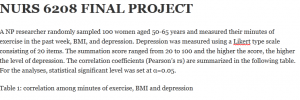NURS 6208 FINAL PROJECT

A NP researcher randomly sampled 100 women aged 50-65 years and measured their minutes of exercise in the past week, BMI, and depression. Depression was measured using a Likert type scale consisting of 20 items. The summation score ranged from 20 to 100 and the higher the score, the higher the level of depression. The correlation coefficients (Pearson’s rs) are summarized in the following table. For the analyses, statistical significant level was set at α=0.05.
Table 1: correlation among minutes of exercise, BMI and depression
| Exercise in past week (minutes) | BMI | |
| BMI | -0.20 | |
| Depression score | -0.30 (P<0.05) | 0.21 |
1. Write a research and null hypotheses regarding the relationship between exercise and depression.
2. Based on the test statistics in table 1, what is you conclusion regarding your research hypothesis? (Hint: discuss both the magnitude and direction of the relationship).
3. What proportion of variance is shared by minutes of exercise and depression among women 50-65 years of age?
4. For the relationship between minutes of exercise and BMI, what was the estimated power of the statistical test? (Using the power table on page 202, table 9.1, Polit 2010). What was the risk that a type II error was committed?
5. If -0.20 is a good estimation of population correction, what sample size would be needed to achieve power of 0.80 at α=0.05?
PART II. (5 points)
Using the “N6208 Final Project Data”, select two variables with nominal or ordinal level measurements, and perform the descriptive statistics (frequency and percentage). [Please select only dichotomous variables from the following list: worknow, poverty, smoker, PoorHealth] . Then perform the bi-variate descriptive statistics using crosstabulation. Hand calculate the ARs, ARR, RR, and OR. Perform a chi-square analysis. Write a report with the following sections:
Introduction: Including the variables, measurement levels, one bivariate research question, and one hypothesis [for example, the event of adverse risk (using your variable name here, for instance, alcohol usage) will be higher/or lower in the risk exposed group (i.e., marijuana use) compare to the non-exposed group (non-users of marijuana)].
Method: Include sample description (sample size, eligibility criteria) and statistical methods used for data analysis. (The sample information can be found in “Polit Dataset Description” in SPSS Data Sets folder).
Results: Include frequencies and percentages for the two variables, crosstabulation results, risk indexes (ARs, ARR, RR, and OR), and chi-square test results. Include a summary table for the results and write your interpretation (Attach SPSS outputs).
Discussion: Write a report including summary and interpretation of the findings reported in the previous sections relative to the research questions you posed.
Part III. (10 points)
Run a one-way ANOVA using the dataset “N6208 Final Project Data”. The Dataset contains 1000 cases from the original PolitDatasetA. Two variables will be used for this analysis: Satisfaction and Houseproblem .
The variable Houseproblem is created using the variable housprob, a summary index of eight variables about current housing problems for the women in this sample—for example, whether or not they had their utilities cut off, had vermin in the household, had unreliable hear, and so forth. The variable housprob is a count of the total number of times the women said “yes” to these eight questions. The variable housprob is recoded into Houseproblem based on number of housing problems. The coding for Houseproblem is: 1=no housing problems, 2=one housing problem, and 3= two or more housing problems.
Satisfaction measures the overall satisfaction with material sell-being. This variable is a summated rating scale variable for women’s responses to their degree of satisfaction with four aspects of their material sell-being—their housing, food, furniture, and clothing for themselves and their children. Each item was coded from 1 (very dissatisfied) to 4 (very satisfied), so the overall score for the four items could range from a low of 4 (4 X 1) to 16 (4 X 4). Higher score indicates greater satisfaction. This scale has an internal consistency Cronbach’s alpha of 0.90. The content validity and construct validity have been established in previous research.
For this analysis, use the variable Houseproblem as the independent (group) variable and variable Satisfaction as the outcome variable. To run the one-way ANOVA, click Analyze → Compare Means → Oneway. In the opening dialogue box, move Satisfaction into the Dependent List and Houseproblem into the slot for Factor. Click the Options pushbutton, and click Descriptives and Homogeneity of Variance, then continue. Next, click the Post Hoc pushbutton and select LSD. Click continue, then OK, and answer these questions:
1. What are the mean levels of satisfaction in the three groups? Report the mean, SD, minimum, maximum and sample size in a table.
2. Write a research question.
3. Write the research hypothesis and the null hypothesis.
4. What was the value of the F statistic?
5. What were the degrees of freedom?
6. What was the probability level for the F statistic? Can the null hypothesis be rejected?
7. According to the LSD test, were any group means significantly different from any others? If yes, which ones?
8. Write a paragraph summarizing the results.
9. Attach the relevant SPSS printouts.